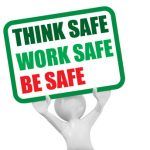
Safety Starts with You

All employers are required to establish a standard of care appropriate for their work circumstances. Once established, it is also the employer’s responsibility to ensure that a program exists to implement and maintain the standards contained in the safety procedures and in policy and procedure development. Prior to establishing safe work procedural standards, the employer must evaluate the risks involved with the work and assess the degree of due diligence required by every employee in order to remain safe. With so many dangers that can be found in the workplace, there are many different training courses available to develop the skills and knowledge needed to keep people safe at work. Different workplaces will have different safety needs and hazards to address, however these are a few of the best courses that ACT offers for workplace safety.
First Aid & CPR
First AID Response & CPR training cannot only reduce pain and suffering, but save lives as well. Receiving a certification in first aid & CPR teaches workers how to remain calm in a potentially life-or-death situation. They are able to perform a quick assessment of an injured person’s condition, and administer basic treatment to keep the person’s condition from worsening. Someone who is certified in CPR is able to resuscitate someone who has fallen unconcious, stopped breathing, or whose heart has stopped completely. Because of the medical knowledge needed to properly perform first aid and CPR, training is required to perform it on the job. Otherwise, the potential outcome of an emergency situation could be disasterous for the injured individual, and put the person who attempted first aid or CPR and the organization as a whole at risk for legal repercussions.
WHMIS Training
Many workplaces, especially medical, scientific and industrial workplaces, work with many different types of chemicals. In many cases, these chemicals can have a wide range of negative effects when they come into contact with people. In 1988, Canada introduced the WHMIS (Workplace Hazardous Materials Information System) to allow workers to be able to identify chemicals and materials that pose a danger to them. This system also helps workers understand the best way to handle them, and the type of protective equipment they will need to wear as well. This system was so effective that in 1992, the United Nations began developing the Global Harmonized System of Classification and Labelling of Chemicals (GHS) which was heavily influenced by the WHMIS system. In 2015, Canada incorporated the GHS into their own WHMIS system to adhere to international standards.
Today, WHMIS training is provided to teach workers about various types of chemical hazards, the effects they can have on exposed people, protective equipment and safe handling practices needed for these hazards, and how to read & interpret Safety Data Sheets which provide extremely detailed information about a chemical. Every workplace uses some type of hazardous chemical, even if they are just cleaning products. So WHMIS training is incredibly useful and necessary to keep workplaces safe and should be provided on a regular basis.
Confined Space Entry
Confined spaces are among the most dangerous places that people can work in. Between the limited range of mobility, awkward body positions workers need to stay in while working within the space, and atmospheric hazards, there is a lot of potential for injuries to occur on the job. This is why legislation has been created to regulate how work is done within a confined space. All job sites that require work within a confined space will need to complete a risk assessment for the confined space that outlines the size of the entry point, amount of room in the confined space, as well as a full air quality test. From there, the employer must develop a complete plan for working in the confined space. This includes outlining the scope of work to be done, who is authorized to enter the space, what type of PPE they need to wear while working in the space, and a comprehensive rescue plan in the event of an emergency. Once this is done, the employer must obtain a permit before anyone can enter the space. Employees must receive adequate training before they can be approved on the permit to enter. Workplaces that need to send people into confined spaces must provide this training and ACT is here to help with that.
Due Diligence Training
Constant diligence is crucial for maintaining a safe workplace. This is a responsibility that every single employee within an organization shares. This may seem like common sense but many workplace injury cases occur because of a lack of diligence. It can be easy to workers to become complacent when they perform the same tasks on a daily basis, and this can lead to them cutting corners, or disregarding safety procedures because they think they can do their job perfectly fine without the perceived tedium of adhering to safety procedures. This is a recipe for disaster. Workplaces that provide due diligence safety training tend to foster workplace cultures that:
- Encourage people to reduce risks and set a good example for their co-workers.
- Consistently develop and implement health and safety practices and provide training to create and maintain safety awareness in the workplace.
- Encourage open discussions and reporting of health and safety issues.
- Provide thorough training before beginning any task, especially high risk activities such as working at heights, hazardous energy control (lockout/tag out), or confined space entry.
- Be aware of the emergency response plans before work begins.
- Much more!
Due diligence training is perfect for creating a safe workplace on an organizational level and should be provided to all employees of a company, regardless of the business sector they belong to.
Create A Safe Work Environment With ACT
A safe work place is crucial and ensuring that you have the right safety procedures and policies for things such as working at heights, first aid CPR, confined space entry, as well as things like WHMIS-GHS can create a great work environment that is safe and productive. Since Advanced Consulting and Training Ltd.’s founding, their diverse team of certified health and safety professionals have taken great pride in their ability to deliver prompt, cost-effective and relevant workplace health and safety solutions. As a CPO approved, TSSA accredited, and WSIB approved provider, we look forward to discussing how ACT can help with your companies’ safety requirements. Contact us today.




